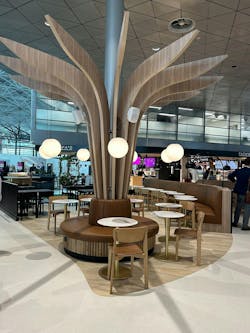The Future of Airport Dining: Embracing Technology for Enhanced Traveler Experience

Airports today serve as bustling centers where travelers seek comfort, convenience, and culinary delights amidst their journeys. This transformation stems from the exponential growth of global travel and the evolving expectations of passengers. No longer satisfied with mere transportation, modern travelers crave a seamless and enriching dining experience that complements their journey while aligning with their dietary preferences and cultural inclinations. Whether it's a gourmet meal or a quick snack, travelers want dining options that are convenient, diverse, and reflective of their individual tastes and preferences.
However, delivering such an experience amidst the hustle and bustle of airport terminals presents its own set of challenges. The sheer volume of passengers, especially during peak travel periods, often leads to overcrowded dining areas, long queues, and delays in service. Managing multiple dining establishments under one roof amplifies the complexity, as each brand may have its own distinct menu, ordering process, and payment system. Balancing the interests of various brands while ensuring equitable revenue distribution adds another layer of intricacy to airport dining management.
In response to these challenges, airports are increasingly turning to innovative technologies to reimagine the dining experience for travelers. SSP, Nordics, a prominent player in the food and beverage industry, has made its mark at more than 180 airports and 300 railway stations. Their dedication to offering exceptional dining experiences and operational excellence drove their decision to collaborate with ACRELEC Nordics, a technology leader specializing in self-service solutions.
The collaboration between ACRELEC and SSP at Arlanda Airport, where the implementation of self-service kiosks and integrated applications has reshaped the landscape of airport dining. These self-service kiosks revolutionize the traditional dining experience by allowing passengers to order from multiple brands through a unified interface. This capability significantly reduces congestion and wait times while empowering travelers to personalize their dining experience according to their preferences.
Transforming Airport Dining Dynamics with Kiosks
The ability to order from multiple brands at one kiosk is transformative for airport dining in several ways. First, it offers travelers a greater variety of options, catering to diverse tastes and dietary requirements. Instead of being limited to the menu of a single restaurant or food outlet, passengers can explore a range of cuisines and offerings from different brands within the airport. This not only enhances the overall dining experience but also ensures that travelers can find options that suit their preferences, whether they're craving a hearty meal, a light snack, or a specialty beverage.
Moreover, ordering from multiple brands at one kiosk streamlines the dining process, saving passengers valuable time and reducing frustration. Instead of navigating through crowded food courts or waiting in separate lines for each dining establishment, travelers can place their orders efficiently and conveniently at a single location. This not only improves the flow of traffic within the airport but also allows passengers to make the most of their limited time between flights, maximizing their dining experience without sacrificing other aspects of their journey.
Additionally, the integration of self-service kiosks and unified ordering systems enhances operational efficiency for airport dining establishments. By consolidating orders from multiple brands into a single interface, staff can streamline order processing, minimize errors, and expedite service delivery. This ensures that travelers receive their meals promptly and accurately, reducing wait times and enhancing overall customer satisfaction. Furthermore, the centralized nature of these systems facilitates seamless communication between different departments and improves coordination among staff, leading to smoother operations and a more cohesive dining experience for passengers.
Ensuring Equitable Revenue Distribution and Data-Driven Insights
In a multi-brand environment, equitable revenue distribution is essential for maintaining fairness and cooperation among different dining establishments. The sophisticated backend systems employed at Arlanda Airport ensure real-time transaction processing and accurate revenue allocation. This transparency fosters trust among participating brands, creating a harmonious operation where all stakeholders benefit. Ensuring each brand receives its fair share of revenue supports a collaborative, rather than competitive, atmosphere.
Technology not only improves the immediate dining experience but also provides valuable data insights. Kiosk usage data helps airports optimize resource allocation, tailor their offerings to meet traveler preferences, and respond dynamically to demand fluctuations. These insights allow airports to remain agile, continually enhancing their services to better meet passenger needs.
By analyzing data on peak dining times, popular menu items, and customer preferences, airports can make informed decisions about staffing, inventory, and menu adjustments. This proactive approach ensures that dining services are always aligned with traveler needs, enhancing satisfaction and operational efficiency.
A Bright Future for Airport Dining
The success at Arlanda Airport sets a precedent for airports worldwide. As travel hubs seek to improve their dining services, they can look to this partnership as a model for innovation. By adopting similar technologies, airports can reduce congestion, enhance traveler satisfaction, and boost operational efficiency. The benefits extend beyond the dining areas, contributing to a more seamless and enjoyable overall travel experience.
By mitigating congestion and expediting service delivery, self-service kiosks have revolutionized dining dynamics at Arlanda Airport. They empower passengers with choice, convenience, and control, transforming stressful dining experiences into moments of relaxation and enjoyment. The data insights gathered from kiosk usage have enabled Arlanda Airport to optimize resource allocation, tailor offerings to evolving preferences, and remain nimble in responding to real-time demand.
The future of airport dining is not just about technology but about creating an environment where travelers feel valued and catered to. By embracing innovation, airports can turn dining areas into vibrant, efficient, and enjoyable spaces that enhance the overall travel experience.
As travelers embark on their journeys through Arlanda, they are greeted not only by the promise of adventure but also by the assurance of a dining experience that is as seamless and satisfying as it is unforgettable.
With the promise of kiosk innovation, airports worldwide are poised to replicate and build upon this success. By focusing on convenience, efficiency, and satisfaction, airports can ensure that dining becomes a highlight of the travel experience, setting a new standard for culinary excellence in transit hubs globally. The future of airport dining is bright, and with continued technological advancements, it promises to make every journey a little more enjoyable.
About the Author

Thibaud Denolle
CEO
Thibaud Denolle moved to Paris in 2013 to join ACRELEC, a global technology company focused on reinventing the customer experience for restaurant and retail brands. He was first involved in the design of NGK self-ordering kiosks for McDonald’s, and in 2018, he set up the U.S. Innovation Center in Chicago. Denolle became the CEO of ACRELEC America in January 2023.